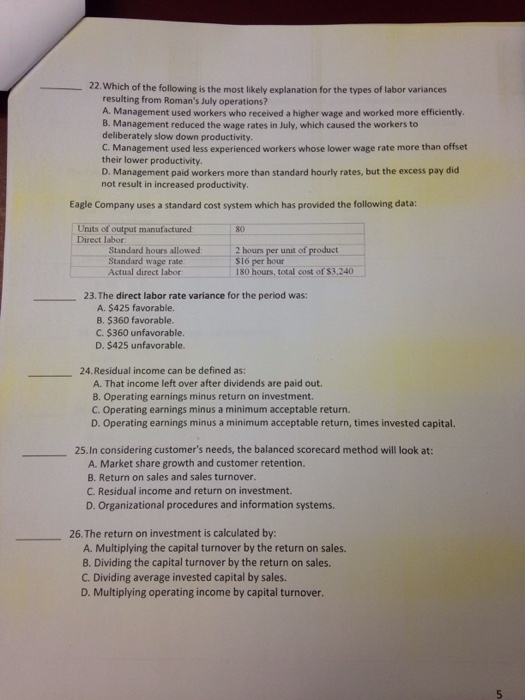-22. Which of the following is the most likely explanation for the types of labor variances resulting from Roman's July operations? A. Management used workers who received a higher wage and worked more efficiently B. Management reduced the wage rates in July, which caused the workers to deliberately slow down productivity C. Management used less experienced workers whose lower wage rate more than offset their lower productivity. D. Management paid workers more than standard hourly rates, but the excess pay did not result in increased productivity Eagle Company uses a standard cost system which has provided the following data: Units of output manufactured Direct labor 80 2 hours per unit of product $16 per hour 180 hours, total cost of $3.240 Standard hours allowed Standard wage rate Actual direct labor 23. The direct labor rate variance for the period was: A. $425 favorable. B. $360 favorable C. $360 unfavorable. D. $425 unfavorable. 24.Residual income can be defined as: A. That income left over after dividends are paid out. B. Operating earnings minus return on investment. C. Operating earnings minus a minimum acceptable return. D. Operating earnings minus a minimum acceptable return, times invested capital. 25.In considering customer's needs, the balanced scorecard method will look at: A. Market share growth and customer retention. B. Return on sales and sales turnover. C. Residual income and return on investment. D. Organizational procedures and information systems. 26. The return on investment is calculated by: A. Multiplying the capital turnover by the return on sales. B. Dividing the capital turnover by the return on sales C. Dividing average invested capital by sales. D. Multiplying operating income by capital turnover. -22. Which of the following is the most likely explanation for the types of labor variances resulting from Roman's July operations? A. Management used workers who received a higher wage and worked more efficiently B. Management reduced the wage rates in July, which caused the workers to deliberately slow down productivity C. Management used less experienced workers whose lower wage rate more than offset their lower productivity. D. Management paid workers more than standard hourly rates, but the excess pay did not result in increased productivity Eagle Company uses a standard cost system which has provided the following data: Units of output manufactured Direct labor 80 2 hours per unit of product $16 per hour 180 hours, total cost of $3.240 Standard hours allowed Standard wage rate Actual direct labor 23. The direct labor rate variance for the period was: A. $425 favorable. B. $360 favorable C. $360 unfavorable. D. $425 unfavorable. 24.Residual income can be defined as: A. That income left over after dividends are paid out. B. Operating earnings minus return on investment. C. Operating earnings minus a minimum acceptable return. D. Operating earnings minus a minimum acceptable return, times invested capital. 25.In considering customer's needs, the balanced scorecard method will look at: A. Market share growth and customer retention. B. Return on sales and sales turnover. C. Residual income and return on investment. D. Organizational procedures and information systems. 26. The return on investment is calculated by: A. Multiplying the capital turnover by the return on sales. B. Dividing the capital turnover by the return on sales C. Dividing average invested capital by sales. D. Multiplying operating income by capital turnover







